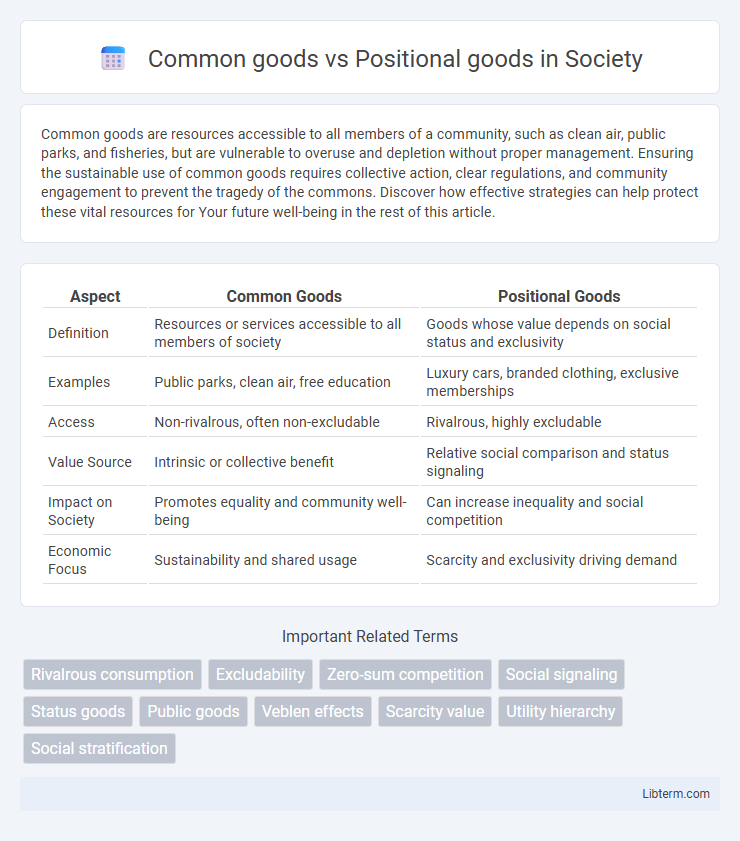Common goods are resources accessible to all members of a community, such as clean air, public parks, and fisheries, but are vulnerable to overuse and depletion without proper management. Ensuring the sustainable use of common goods requires collective action, clear regulations, and community engagement to prevent the tragedy of the commons. Discover how effective strategies can help protect these vital resources for Your future well-being in the rest of this article.
Table of Comparison
| Aspect | Common Goods | Positional Goods |
|---|---|---|
| Definition | Resources or services accessible to all members of society | Goods whose value depends on social status and exclusivity |
| Examples | Public parks, clean air, free education | Luxury cars, branded clothing, exclusive memberships |
| Access | Non-rivalrous, often non-excludable | Rivalrous, highly excludable |
| Value Source | Intrinsic or collective benefit | Relative social comparison and status signaling |
| Impact on Society | Promotes equality and community well-being | Can increase inequality and social competition |
| Economic Focus | Sustainability and shared usage | Scarcity and exclusivity driving demand |
Introduction to Common Goods and Positional Goods
Common goods are resources or products that are non-excludable and rivalrous, meaning they are accessible to all but can be depleted through overuse, such as fisheries or public parks. Positional goods derive their value primarily from their scarcity and social status they confer, exemplified by luxury cars or designer clothing, where value increases as fewer people own them. Understanding the distinction between these goods is crucial for addressing economic allocation, sustainability, and social equity challenges.
Defining Common Goods: Characteristics and Examples
Common goods are resources characterized by their non-excludability and rivalrous consumption, meaning individuals cannot be effectively excluded from use, but one person's consumption reduces availability for others. Examples include fisheries, groundwater basins, and public pastures, where overuse can lead to depletion or degradation. These goods require collective management to prevent the "tragedy of the commons" and ensure sustainable utilization.
Understanding Positional Goods: Features and Significance
Positional goods are items whose value is derived primarily from their exclusivity and status rather than intrinsic utility, making their desirability dependent on social comparison. These goods often include luxury cars, designer clothing, and real estate in prime locations, where ownership signals wealth and prestige. Understanding positional goods is crucial for analyzing consumer behavior and market dynamics driven by status competition rather than pure functional benefits.
Economic Theories Behind Common and Positional Goods
Common goods are defined by their non-excludability and rivalry in consumption, making them susceptible to overuse and depletion as described by the tragedy of the commons theory. Positional goods derive value primarily from their scarcity and status symbolism, reflecting Veblen's theory of conspicuous consumption where utility is dependent on relative social ranking rather than absolute abundance. Economic theories highlight that managing common goods requires collective governance to prevent resource exhaustion, whereas positional goods promote competitive consumption driven by social comparison and signaling.
Scarcity and Access: A Comparative Framework
Common goods are characterized by their non-excludability and rivalrous consumption, meaning scarcity arises as users compete for limited resources, often leading to depletion without managed access. Positional goods, by contrast, derive value primarily from their exclusivity and status signaling, with scarcity intentionally maintained through controlled access or production limits to preserve social differentiation. Understanding these distinctions highlights how management strategies differ: common goods require collective governance to balance access and sustainability, whereas positional goods rely on restricted supply to maintain desirability and market prestige.
Social Implications of Common Goods vs. Positional Goods
Common goods, characterized by shared access and collective benefit, foster social cohesion and equitable resource distribution, reducing conflict and promoting community well-being. Positional goods, valued for their exclusivity and status signaling, can exacerbate social inequality and competition, leading to social stratification and decreased overall societal trust. The social implications highlight that common goods enhance cooperative frameworks, while positional goods often intensify disparities and social tensions.
Market Dynamics and Value Creation
Common goods, characterized by non-excludability and rivalry, often face market dynamics driven by overuse and depletion risks, which can reduce their long-term value and necessitate collective management for sustainable value creation. Positional goods derive value primarily from exclusivity and scarcity, influencing market dynamics through competitive consumption and social status signaling, which enhances their perceived worth among consumers. Market mechanisms for common goods emphasize resource allocation and preservation, while positional goods focus on differentiation and social hierarchy to maximize value creation.
The Role of Policy in Managing Common and Positional Goods
Policy plays a crucial role in managing common goods by implementing regulations that prevent overuse and ensure sustainable access, such as fishing quotas and pollution limits. In contrast, policies addressing positional goods often focus on reducing inequality and promoting fair distribution through taxation, subsidies, or anti-monopoly laws. Effective governance balances the preservation of common resources with the equitable allocation of positional goods to enhance social welfare and economic stability.
Challenges in Distribution and Fairness
Common goods face challenges in distribution due to their non-excludable and rivalrous nature, leading to overuse and depletion known as the "tragedy of the commons." Positional goods create fairness issues because their value depends on relative status, causing unequal access and social stratification. Efficient allocation of both types requires balancing scarcity, demand, and equitable access to prevent social conflicts and resource degradation.
Future Trends and Emerging Debates
Future trends in common goods emphasize collaborative management and digital commons, leveraging blockchain and AI to enhance transparency and equitable access. Emerging debates focus on balancing individual incentives and collective benefits amid rising environmental concerns and resource scarcity. The contrast with positional goods, which rely heavily on exclusivity and social status, underscores growing tensions in policy frameworks addressing sustainability and social equity.
Common goods Infographic

 libterm.com
libterm.com